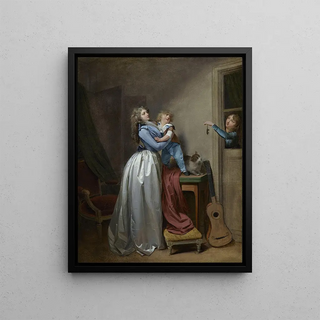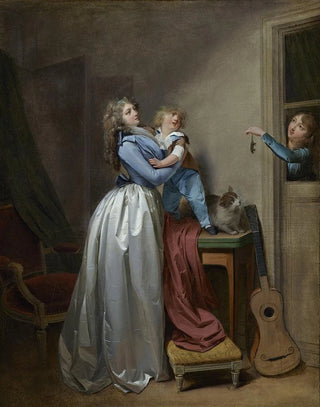Art print | The Dead Mouse - Louis Léopold Boilly


View from behind

Frame (optional)
Art print La mouse dead - Louis Léopold Boilly – Engaging introduction
In the vast panorama of 18th-century art, "La mouse dead" by Louis Léopold Boilly stands out for its boldness and subtlety. This work, both intriguing and unsettling, invites the viewer to delve into a universe where still life transcends mere representation to become a true mirror of human emotions. The mouse, a symbol of fragility and vulnerability, is staged with remarkable delicacy, revealing an aesthetic that questions our relationship with life and death. Boilly's choice to depict a dead animal, far from being trivial, prompts us to reflect on the ephemeral beauty of existence and on how art can capture moments of truth.
Style and uniqueness of the work
Boilly's style, characterized by meticulous attention to detail and a rich, vibrant color palette, gives "La mouse dead" an atmosphere that is both realistic and poetic. The artist excels in depicting textures, whether it is the mouse's fur or the surrounding elements, creating a striking contrast between life and death. The composition is carefully orchestrated, with each element having its place and contributing to the overall harmony of the piece. The light, soft and diffuse, caresses the surfaces, accentuating volumes and shadows, while the neutral background allows the mouse to stand out with dramatic intensity. This approach, typical of Boilly's style, demonstrates impressive technical mastery that invites prolonged contemplation.
The artist and his influence
Louis Léopold Boilly, an emblematic figure of the French artistic movement, managed to establish himself through his innovative approach and daring thematic choices. Born in 1761, he experienced the upheavals of his time, adapting his art to the socio-cultural changes around him. Boilly is recognized for his ability to capture scenes of everyday life with a unique sensitivity, blending still life with elements of portraiture and genre scenes. His influence extends beyond his time, inspiring many artists who saw in him a precursor of modernity. "La

Matte finish

View from behind

Frame (optional)
Art print La mouse dead - Louis Léopold Boilly – Engaging introduction
In the vast panorama of 18th-century art, "La mouse dead" by Louis Léopold Boilly stands out for its boldness and subtlety. This work, both intriguing and unsettling, invites the viewer to delve into a universe where still life transcends mere representation to become a true mirror of human emotions. The mouse, a symbol of fragility and vulnerability, is staged with remarkable delicacy, revealing an aesthetic that questions our relationship with life and death. Boilly's choice to depict a dead animal, far from being trivial, prompts us to reflect on the ephemeral beauty of existence and on how art can capture moments of truth.
Style and uniqueness of the work
Boilly's style, characterized by meticulous attention to detail and a rich, vibrant color palette, gives "La mouse dead" an atmosphere that is both realistic and poetic. The artist excels in depicting textures, whether it is the mouse's fur or the surrounding elements, creating a striking contrast between life and death. The composition is carefully orchestrated, with each element having its place and contributing to the overall harmony of the piece. The light, soft and diffuse, caresses the surfaces, accentuating volumes and shadows, while the neutral background allows the mouse to stand out with dramatic intensity. This approach, typical of Boilly's style, demonstrates impressive technical mastery that invites prolonged contemplation.
The artist and his influence
Louis Léopold Boilly, an emblematic figure of the French artistic movement, managed to establish himself through his innovative approach and daring thematic choices. Born in 1761, he experienced the upheavals of his time, adapting his art to the socio-cultural changes around him. Boilly is recognized for his ability to capture scenes of everyday life with a unique sensitivity, blending still life with elements of portraiture and genre scenes. His influence extends beyond his time, inspiring many artists who saw in him a precursor of modernity. "La






